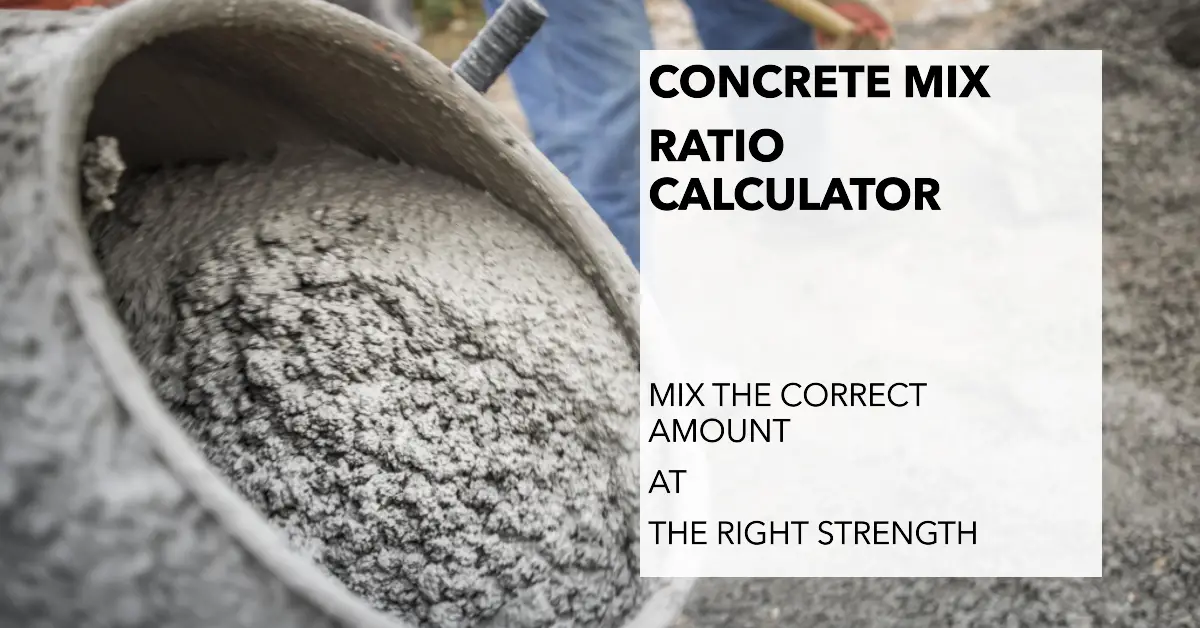This concrete mix ratio calculator helps you determine the quantities of cement, sand, and aggregate required for your concrete mixture based on the desired volume and selected mix ratio.
To use the concrete mix ratio calculator, follow these steps:
- Open the web page containing the calculator in a web browser.
- Select the desired mix ratio from the dropdown menu. The available options include C20 1:2:4 concrete mix calculator , C25, C30, C35, C40, and C45. Each mix ratio represents a specific combination of cement, sand, and aggregate.
- Enter the desired volume of concrete in cubic meters (m³) in the input field provided. This represents the amount of concrete you want to produce.
- Click the “Calculate” button. The calculator will perform the necessary calculations based on the selected mix ratio and desired volume.
- The result section will display the quantities of cement, sand, and aggregate required in kilograms (kg) based on the selected mix ratio and desired volume.
UK Concrete Mix Ratio Calculator
You might use the concrete mix ratio calculator for several reasons:
- Material Planning: The calculator helps in planning the quantities of cement, sand, and aggregate required for a specific volume of concrete. It ensures that you have accurate information to order the right amount of materials, helping avoid shortages or excesses during construction projects.
- Cost Estimation: By knowing the quantities of materials needed, you can estimate the costs associated with the concrete mixture. This information is valuable in budgeting and project planning.
- Quality Control: The mix ratio plays a crucial role in determining the strength and durability of concrete. By using the calculator, you can ensure that you maintain the desired mix proportions to achieve the required concrete strength and performance.
- Consistency: The calculator ensures consistency in the mix ratio across different batches of concrete. This consistency is important for maintaining uniformity in construction projects and meeting engineering specifications.
- Efficiency: By accurately calculating the required quantities of materials, the calculator helps optimize resource utilization and minimize wastage.
Using the concrete mix ratio calculator can save time and provide confidence in producing concrete with the right proportions for your specific project requirements. It is a valuable tool for contractors, engineers, and individuals involved in construction projects.
FAQ’s
What is the mix ratio of C20 concrete?
The mix ratio of C20 concrete is typically 1:2:4. This means that for every part of cement, you would use two parts of sand and four parts of coarse aggregate.
How much sand required for M20 concrete?
The amount of sand required for M20 concrete depends on the mix ratio. In the case of the standard mix ratio of 1:1.5:3 (cement:sand:aggregate) for M20 concrete, the proportion of sand would be 1.5 times the volume of cement. For example, if you have 1 cubic meter of cement, you would need 1.5 cubic meters of sand.
How much sand is added on concrete?
The amount of sand added to concrete depends on the mix design and the specific requirements of the project. Sand is one of the primary components of concrete and is typically used as a fine aggregate. It is added in the appropriate proportion to achieve the desired strength and workability of the concrete mixture.
How do you mix Grade 20 concrete?
To mix Grade 20 concrete, you would typically follow these steps:
Start by calculating the volume of materials needed based on the desired quantity of concrete.
Combine the cement, sand, and coarse aggregate in the correct ratio (e.g., 1:2:4) in a mixing container or concrete mixer.
Mix the dry ingredients thoroughly until they are well-distributed.
Gradually add water while continuously mixing until you achieve a workable consistency. Avoid using excessive water, as it can weaken the concrete.
Continue mixing for several minutes to ensure the ingredients are uniformly combined.
The Grade 20 concrete mixture is now ready for use. Pour or place it into the desired formwork or construction area.
What is the mix for C30 concrete?
The mix ratio for C30 concrete is typically 1:0.8:1.5, which means for every part of cement, you would use 0.8 parts of sand and 1.5 parts of coarse aggregate.
How long does C30 concrete take to set?
The setting time for C30 concrete can vary depending on several factors, including the ambient temperature, water-cement ratio, and the use of accelerators or retarders. In general, C30 concrete may take approximately 6 to 8 hours to initially set, and it continues to gain strength over time.
What is the ratio of sand to aggregate in concrete?
The ratio of sand to aggregate in concrete can vary depending on the desired strength and workability of the concrete mixture. A common ratio is 1:2 to 1:3, where for every part of cement, you would use 2 to 3 parts of combined sand and coarse aggregate.
What is the best ratio of concrete?
The best ratio of concrete depends on the specific requirements of the project, including the desired strength, durability, and workability. Different applications may require different ratios to meet the project specifications. It is recommended to consult with a structural engineer or follow local building codes and standards for the appropriate concrete mix ratio.
Should I add sand to concrete?
Sand is already an essential component of concrete mixes. It provides workability and strength to the mixture. Adding additional sand to the concrete mix is unnecessary unless specified by the project requirements or a specific mix design.
How much sand and gravel do I mix with concrete?
The amount of sand and gravel (coarse aggregate) you need to mix with concrete depends on the desired mix ratio and the total volume of concrete required. Different mix ratios will have varying proportions of sand and gravel. It is recommended to use the specified mix ratios provided by structural engineers or follow local building codes for accurate proportions.
What is the mix ratio for C45 concrete?
The mix ratio for C45 concrete is typically 1:0.5:1.2, which means for every part of cement, you would use 0.5 parts of sand and 1.2 parts of coarse aggregate.
How many bags of cement are in a Grade 20 concrete?
The number of bags of cement required for Grade 20 concrete depends on the mix ratio, the volume of concrete, and the weight of each bag of cement. To determine the exact number, you would need to know the specific mix ratio and the weight (in kg) of each bag of cement.
How many 20kg bags of cement in 1 cubic meter of concrete?
The number of 20kg bags of cement required for 1 cubic meter of concrete depends on the mix ratio and the weight of each bag of cement. To determine the exact number, you would need to know the specific mix ratio and the weight (in kg) of each bag of cement.
How much sand and cement do I need per m2 of concrete?
The amount of sand and cement needed per square meter depends on the thickness of the concrete layer and the mix ratio. To calculate the exact amount, you would need to know the specific mix ratio and the desired thickness of the concrete layer.
How much sand stone and cement to make 1 cubic meter of concrete?
To make 1 cubic meter of concrete, the amount of sand, stone (coarse aggregate), and cement required depends on the mix ratio. The specific proportions can vary, but a common mix ratio is 1:2:3 (cement:sand:stone) by volume. This means for 1 cubic meter of concrete, you would need approximately 0.28 cubic meters of cement, 0.56 cubic meters of sand, and 0.84 cubic meters of stone.
How much cement do I need for 2 cubic meters?
To determine the amount of cement needed for 2 cubic meters of concrete, you would need to know the specific mix ratio. Assuming a common mix ratio of 1:2:3 (cement:sand:stone), you would require approximately 0.56 cubic meters of cement.
How many 25kg bags of cement in 1 cubic meter of sand gravel?
The number of 25kg bags of cement required for 1 cubic meter of sand and gravel (coarse aggregate) depends on the mix ratio and the weight of each bag of cement. To determine the exact number, you would need to know the specific mix ratio and the weight (in kg) of each bag of cement.
How much sand and gravel do I mix with concrete?
The amount of sand and gravel (coarse aggregate) to be mixed with concrete depends on the desired mix ratio and the volume of concrete required. Different mix ratios will have varying proportions of sand and gravel. It is recommended to use the specified mix ratios provided by structural engineers or follow local building codes for accurate proportions.
Conclusion
In conclusion, the concrete mix ratio calculator is a useful tool for accurately determining the quantities of cement, sand, and aggregate required for a specific volume of concrete. By selecting the desired mix ratio and entering the desired volume, the calculator provides the necessary information to ensure proper material planning, cost estimation, and quality control in construction projects.
By using the calculator, you can optimize resource utilization, minimize wastage, and maintain consistency in the mix ratio across different batches of concrete. This helps ensure that the concrete produced meets the required strength and performance criteria.
Whether you are a contractor, engineer, or individual involved in construction projects, the concrete mix ratio calculator provides a convenient and efficient way to plan and estimate the materials needed for your concrete mix. It saves time, provides accuracy, and enhances confidence in achieving the desired results.
By leveraging the concrete mix ratio calculator, you can streamline your construction processes, enhance project management, and contribute to the successful execution of your concrete-related endeavors.
Author Profile

- I have many qualifications and certificates in construction, such as City & Guilds, CPCS and CITB. These are the highest standards of training and competence in the industry. Whether you need help with plumbing, carpentry, bricklaying or any other trade, I’m here to help you succeed.
Latest entries
- March 6, 2024CalculatorsWall Tile Calculator: How Many Wall Tiles Do You Need
- February 29, 2024Roof Truss Cost Calculator
- December 31, 2023Wage Take Home Calculator
- December 30, 2023Day Rate Calculator

